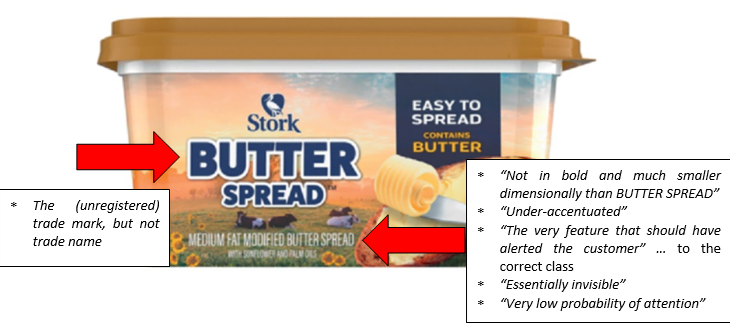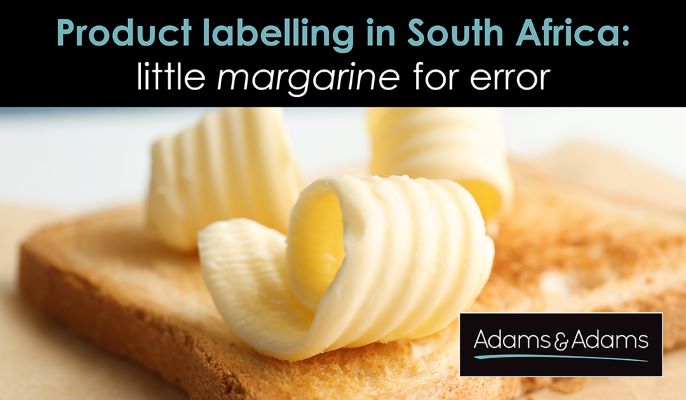Round 3 was decided with Clover winning the war (despite losing a battle along the way) after a favourable decision was recently churned out by the Supreme Court of Appeal (SCA). Readers may remember that the writer first reported in June 2021 that Clover’s urgent application to interdict the use of STORK BUTTER SPREAD by Siqala (known to us as Stork) was unsuccessful, due to a lack of urgency.
Clover had a second bite of the buttered bread and was successful in securing an order against Stork in November 2021 entailing, inter alia, that Stork be interdicted from competing unlawfully with Clover by using the offending product label. Stork, not backing down, took this decision on appeal and for purposes of this article, the focus will be on the decision handed down by the SCA on 31 May 2023, as far as it relates specifically to the product label.
By way of reminder, Clover objected to Stork promoting, marketing, distributing, and selling a product as a butter product, when it was in fact not such a product, but a modified butter product. Clover objected to the product label being used which it felt misrepresented modified butter as a butter product.
Relevant to this dispute, are the provisions of the Agricultural Product Standards Act 119 of 1990 (the Act) and the relevant regulations published thereunder, which:

- first, regulate and prescribe, amongst others, the size of the marks that may be imprinted on a product label or container (Section 3 of the Act read with Regulations 2(1)(d) and (e) and 26(7)(a)); and,
- second, prohibits the use of any mark that conveys or creates, or is likely to convey or create, a false or misleading impression as to the nature, class or identity of a product (Section 6 of the Act read with Regulations 32(3)(a) and 32(4)).
Below, a depiction of the product label used, together with the court’s remarks regarding certain elements:
Clover contended that the product label, viewed as a whole, not only contravenes the statutory labelling prohibitions, but also misrepresents or is likely to create the impression that the Stork’s modified butter product, is in fact a butter product.
The Court found that there were 5 questions for consideration and for the sake of brevity, only two of the questions, below, will be discussed:
- Do the marks in the product label contravene the statutory labelling requirement?
- Does Stork’s product label misrepresent, or is it likely to misrepresent and create a misleading impression, that the product is of another nature, composition, class or identity?
With regard to question 1, Sections 3(1)(a)(iii) and (v) of the Act empower the Minister to prohibit the sale of a product, unless the labelling of that product complies with the prescribed requirements. In terms of Regulation (2)(1)(d) “no person shall sell a dairy product or imitation dairy product in the Republic of South Africa… unless a container and outer container in which such product is packed, is marked with particulars and in a manner set out in Regulations 26 to 31”. And in terms of Regulation 26(7)(a) “no words or expression (on a label) may be bigger than the class designation, unless it is a registered trade mark or trade name” (emphasis added).
There is no definition in the regulations for a “trade name”, and a “registered trade mark” is defined as a trade mark registered in terms of the Trade Marks Act 194 of 1993 (the Trade Marks Act). The relevance of this will become apparent below.
To be clear, there was no dispute that the relevant product class was modified butter and not butter.
In the judgment, the Honourable Justice Ponnan went to great lengths to describe how, and seemingly took a dim view of the fact that, the Applicant had changed its position in referring to STORK BUTTER SPREAD, first as a trade mark and then later a trade name. When seeking clearance for its product label, Stork had apparently referred to its STORK BUTTER SPREAD trade mark (no reference to the mark being registered, by Stork) and in the response to the demand sent, reference was also made to Stork’s trade mark (no reference to the mark being registered, by Stork).
Of course, if STORK BUTTER SPREAD was a registered trade mark (or a trade name, for that matter), it could appear “bigger” on the label, than the class designation.
In its answering affidavit, Stork stated that “whether or not STORK BUTTER SPREAD is a registered trade mark is…wholly irrelevant”. The Honourable Justice Ponnan considered it significant that Stork did not specifically state at that stage that STORK BUTTER SPREAD is a trade name. Stork ultimately (and perhaps impermissibly so) in a fourth affidavit submitted that “for the avoidance of all doubt” STORK BUTTER SPREAD is a trade name.
A search of CIPC’s records has confirmed that STORK BUTTER SPREAD is not a registered trade mark, but that there is a pending application for the mark, with the status reflected as “oppositions lodged”. As mentioned above and as apparent from the ruling, it was never Stork’s case that it owned a registered trade mark.
The writer would argue that there was nothing untoward in Stork referring to STORK BUTTER SPREAD as filed, as a trade mark, in these circumstances.
Even if STORK BUTTER SPREAD is not a registered trade mark, why could it not qualify as a trade name, for purposes of Regulation 27(6)(a)? A trade name is not defined in the Act or regulations and most IP practitioners would accept that a trade name, could equally be considered a trade mark. In fact, the Trade Marks Act defines a mark as any sign capable of being represented graphically, with no express list being provided, but “a name” being included as a possibility.
Be that as it may, the Honourable Justice Ponnan took a different view and found that because STORK BUTTER SPREAD was not a registered trade mark (and Stork was not permitted to belatedly attempt to escape the consequences of that, by referring to a trade name), that the Provisions of Section 3, read with Regulations 2(1)(d) and 26(7)(a) were contravened.
Even if the court had found that STORK BUTTER SPREAD is a trade name which could be expressed bigger than the class designation, the second question referred to above would still have to be considered. In other words, the court would still have to consider whether Stork is using a mark that conveys or creates, or is likely to convey or create, a false or misleading impression as to the nature, class or identity of a product. No use crying over spilled milk.
With regard to the second question, the court confirmed that it is not necessary to peer too closely at the offending article to make the determination as to whether it is likely to mislead and that it should notionally transport itself from the court room to the marketplace and look at the article as it is seen by the consumers. Although not peering closely, the court seemingly had a good look at the elements of the product label (and the different sizes, etc. used), as can be seen from the commentary above.
From the Judgement, it is apparent that Stork relied on (or attempted to rely on) evidence in the form of qualitative consumer research on the intended label (the Melange Proposal), an assessment of the effectiveness of the label with particular emphasis on what was described as the “stand-out” of the label (the VAS analysis) and lastly a market survey to determine whether the STORK BUTTER SPREAD product would be interpreted by consumers to be pure butter (referred to as Project Lard).
There was much debate about whether the expert evidence should be admissible, but what was interesting to read is that the court found that the outcome of the VAS analysis, read together with the Melange Proposal, suggested (irresistibly so according to the Honourable Justice Ponnan) that the product label was fashioned to focus consumer attention on the word “butter”. One has to wonder about the circumstances leading to Stork relying on this evidence, in support of its case.
With regard to the outcome of Project Lard, the court was particularly critical about the survey and commented, inter alia, that the survey ignored the national market place and the national consumer, who would encounter Stork’s product, cheek by jowl with other products. According to the judgement, the survey involved, inter alia, a questionnaire being completed by butter and/or butter spread users, which entailed qualifying participants being shown a various range of (pure) butter and modified butter products (the offending product was seemingly included, as there is reference to product recognition, despite the short period the offending product had been on shelves) and being asked to categorise each one as either:
- Butter;
- Butter Spread;
- Margarine;
- None of the above;
- Other – with a reason to be specified.
The court found it significant that the survey concluded that a significant number of the participants identified and categorised the product (not specifically confirmed that this is the offending product, but one would assume so) as “butter” and “butter spread”. Only 5% categorised the product as “margarine” or “something else”. The court was impressed by the fact that 94% of the participants, identified the product as “butter” and “butter spread”.
The judgement ultimately concluded that although the survey is hearsay, it can be admitted as evidence. Despite further suggesting that the evidence could be rejected as unreliable, the court concluded that to the extent that reliance can be placed on the evidence, it appeared to warrant the inference that Stork had, in adopting the product label, acted out “a common charade”.
And so, the court did ultimately conclude that the offending product label would convey or create a false or misleading impression as to the nature or class of the product and the notional consumer would (or at least, would likely) be deceived or confused that the product is a butter product, which it is not.
Stork has to wonder whether the reference to STORK BUTTER SPREAD as a trade name (and not a trade mark) earlier in the proceedings would have made a difference to the outcome of question 1. That being said, even if Stork had been permitted to give more prominence to STORK BUTTER SPREAD, as a trade name, the name would still have resulted in the likelihood of confusion, considering how the court wheyed the elements of the label and the expert evidence submitted.
Clover must certainly be relieved that the cows have now come home.
Article by Jani Cronjé – Partner, Trade Mark Litigation








